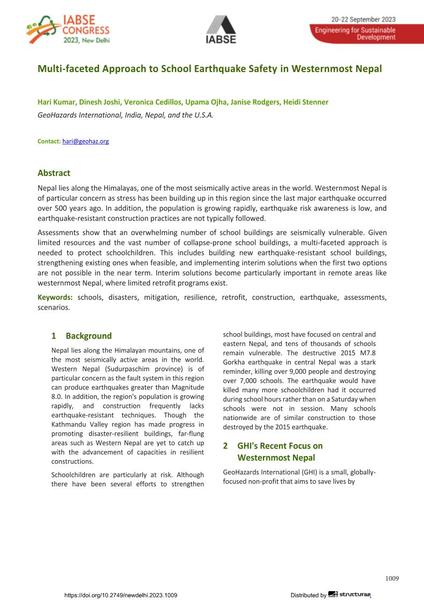Multi-faceted Approach to School Earthquake Safety in Westernmost Nepal

|
|
|||||||||||
Bibliographic Details
| Author(s): |
Hari Kumar
(GeoHazards International, India, Nepal, and the U.S.A.)
Dinesh Joshi (GeoHazards International, India, Nepal, and the U.S.A.) Veronica Cedillos (GeoHazards International, India, Nepal, and the U.S.A.) Upama Ojha (GeoHazards International, India, Nepal, and the U.S.A.) Janise Rodgers (GeoHazards International, India, Nepal, and the U.S.A.) Heidi Stenner (GeoHazards International, India, Nepal, and the U.S.A.) |
||||
|---|---|---|---|---|---|
| Medium: | conference paper | ||||
| Language(s): | English | ||||
| Conference: | IABSE Congress: Engineering for Sustainable Development, New Delhi, India, 20-22 September 2023 | ||||
| Published in: | IABSE Congress New Delhi 2023 | ||||
|
|||||
| Page(s): | 1009-1017 | ||||
| Total no. of pages: | 9 | ||||
| DOI: | 10.2749/newdelhi.2023.1009 | ||||
| Abstract: |
Nepal lies along the Himalayas, one of the most seismically active areas in the world. Westernmost Nepal is of particular concern as stress has been building up in this region since the last major earthquake occurred over 500 years ago. In addition, the population is growing rapidly, earthquake risk awareness is low, and earthquake-resistant construction practices are not typically followed. Assessments show that an overwhelming number of school buildings are seismically vulnerable. Given limited resources and the vast number of collapse-prone school buildings, a multi-faceted approach is needed to protect schoolchildren. This includes building new earthquake-resistant school buildings, strengthening existing ones when feasible, and implementing interim solutions when the first two options are not possible in the near term. Interim solutions become particularly important in remote areas like westernmost Nepal, where limited retrofit programs exist. |
||||
| Keywords: |
earthquake construction assessments schools resilience retrofit mitigation scenarios Disasters
|
||||

